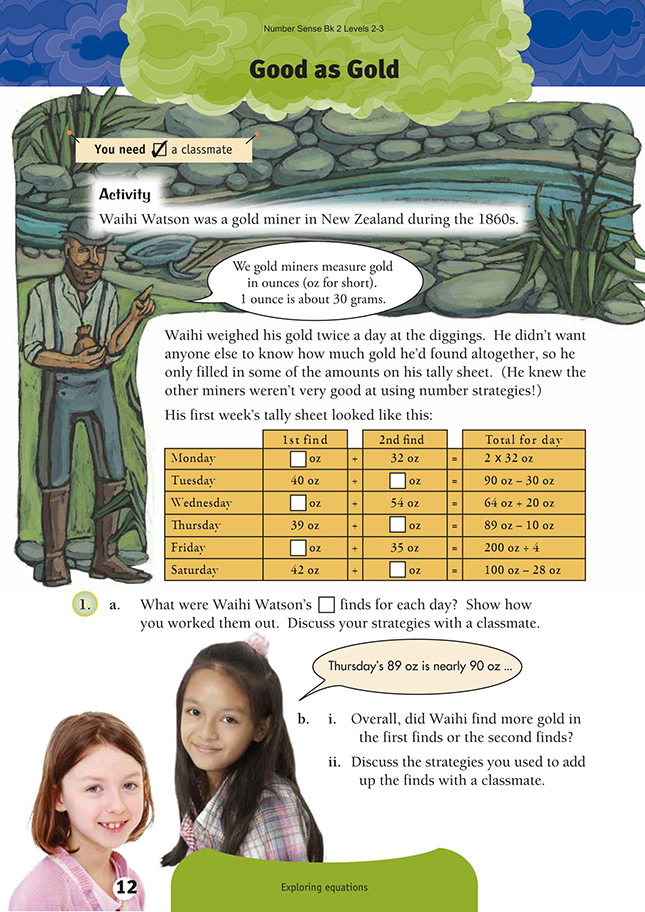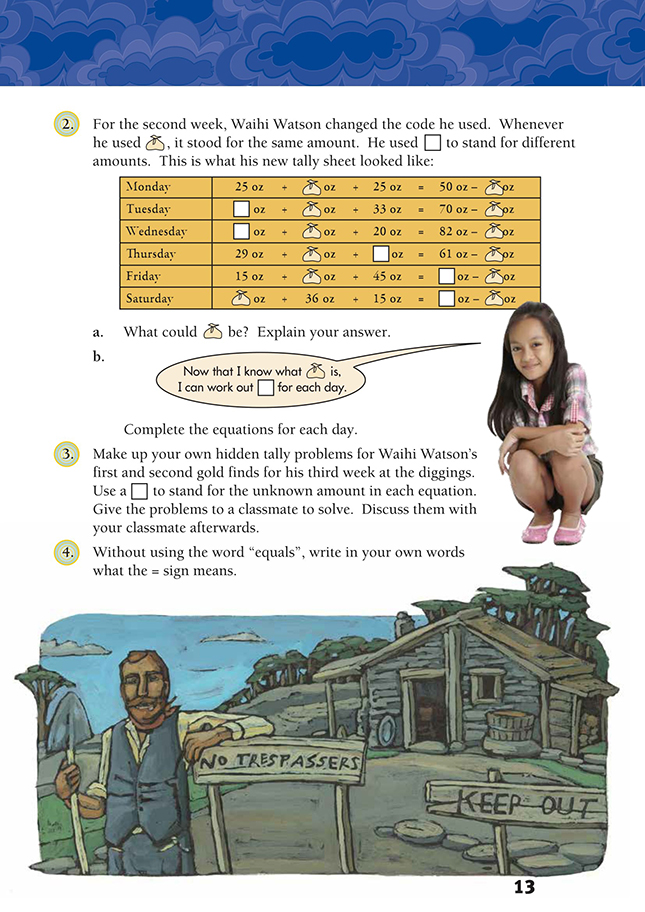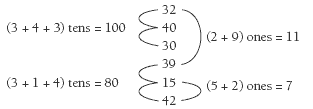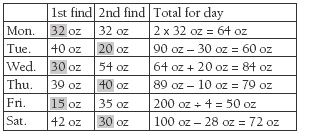This is a level 3 number activity from the Figure It Out series. It relates to Stage 6 of the Number Framework.
A PDF of the student activity is included.
Click on the image to enlarge it. Click again to close. Download PDF (393 KB)
use mental strategies to solve addition and subtraction problems
solve algebraic equations
Number Framework Links
Use this activity to:
• encourage transition from early additive strategies (stage 5) to advanced additive strategies (stage 6) in the domain of addition and subtraction
• help the students who are using advanced additive strategies (stage 6) in the domain of addition and subtraction to develop parallel multiplicative strategies.
FIO, Levels 2-3, Number Sense and Algebraic Thinking, Book Two, Good as Gold, pages 12-13
A classmate
By changing the position of the unknown value in the equations, this activity challenges students to think carefully about the meaning of each situation and the strategy used to solve it. It extends the challenge by having students solve equations that also contain a symbol that represents the same amount. The historical context provides interest and an opportunity to integrate mathematics within essential learning areas such as social studies and technology.
You could introduce the activity by showing the students some goldmining areas on a map of New Zealand. In addition, discuss the ounce as a historical unit of mass. The students could get a feel for 1 ounce by putting 2 full tablespoons (30 millilitres) of water in a plastic bag.
For question 1, model ways to read each equation with an emphasis on the place of the unknown. For example: What plus 32 ounces will equal 2 times 32 ounces? 40 ounces plus what equals 30 ounces less than 90 ounces?
Let the students solve each equation and report on their strategies. Emphasise the importance of deciding which calculation to do first. Discuss with them the distinctive features of each day’s equation and what mental strategies the students used:
• Monday: This is a doubles situation.
• Tuesday: The total for the day must be between 40 and 90.
• Wednesday: This uses a – 10 and + 10 compensation strategy. (64 – 10 = 54; 20 + 10 = 30)
• Thursday: This can be solved using + 50 – 10 to connect the 39 with 89 – 10.
• Friday: 200 ÷ 4 is the same as 100 ÷ 2. This is an equal adjustment using division.
• Saturday: What compatible number goes with 28 to make 100?
To solve question 1b, the students will add 6 numbers, so they could use a place value strategy where they add the tens and the ones separately and then add them together. It doesn’t matter if they add the tens before the ones, for example:
The tens equal 180. The ones equal 18. So the total equals 198.
Introduce question 2 by focusing on the code used for the same amount with a question such as:
Does it matter what number the “bag of gold” is worth? To work this out with number properties, have the students look carefully at Monday’s situation to find the value of the bag of gold. Use questions such as What number can you add to the left side and take from the right side that will keep the equation balanced? The students should realise that the bag of gold must be worth 0.
The students need to see that an equation is a statement of balance and that this is indicated by the equals sign. Use question 4 to ensure that the students appreciate this point.
Answers to Activity
1. a.
Methods will vary. Strategies could include number lines, rounding and compensation
(for example, 89 – 10 = 90 – 10 – 1), or using known facts (9 – 3 = 6 and 4 + 2 = 6
for Tuesday). For example, Thursday’s first finds could be
worked out like this:
89 – 10 = 90 – 10 – 1
= 80 – 1
= 79
Or: 89 – 10 = 80 – 10 + 9 = 79
79 – 39 = 40
So 39 + 40 = 79
Or:
b. i. He found more gold in the second finds. (First finds: 198; second finds: 211)
ii. Strategies will vary. See the examples above.
2. a. 0. Explanations may vary. It can only be 0 because two of Monday’s finds already total 50 (and you cannot have less than a 0 find).
b. Monday: 25 + 0 + 25 = 50 – 0
Tuesday: 37 + 0 + 33 = 70 – 0
Wednesday: 62 + 0 + 20 = 82 – 0
Thursday: 29 + 0 + 32 = 61 – 0
Friday: 15 + 0 + 45 = 60 – 0
Saturday: 0 + 36 + 15 = 51 – 0
3. Problems and discussion will vary.
4. Explanations will vary. For example:
= means there is the same value on both sides.
= means that the sides balance.



